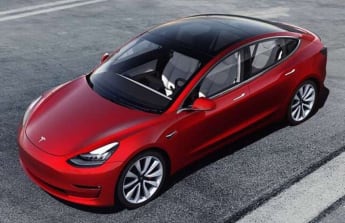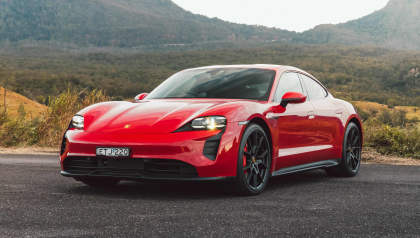The Model 3 Performance is a car which presents you with one simple question.
What are you willing to sacrifice to acquire the fastest car on the road? Maybe it’s a few thousand dollars? Maybe it’s driving around in a symbol of Elon Musk? Maybe it’s something else you don’t expect?
For now, though, forget what you know about the Model 3, because the new Performance resets expectations for just how quick an electric car can be. Read on for the details.
Tesla Model 3 2024: Performance
| Engine Type | Not Applicable, 0.0L |
|---|---|
| Fuel Type | Electric |
| Fuel Efficiency | 0.0L/100km (combined) |
| Seating | 5 |
| Price From | $67,540 - $77,660 |
| Safety Rating |
|
Price and features - Does it represent good value for the price? What features does it come with?
8 / 10
Put simply, there is no more affordable way to be this fast. Now priced from $80,900 plus on-road costs, the Model 3 Performance is the fastest it has ever been, sprinting from 0-100km/h in just 3.1 seconds. And, at least at the time of writing, it was only about $22,000 (no, wait, it’s $26,000) more than the entry-level Model 3 Rear Wheel Drive. This pricing will no doubt change next week, so maybe check when you’re ready to buy.
Regardless, the point is the jump isn’t ridiculous, but the performance upgrade is. This top-spec Tesla nearly doubles the power and halves the sprint time of its lesser sibling. Seriously. It’s faster than a Lamborghini Huracan, or a Ferrari Roma, or versions of the Porsche Taycan with price tags more than double that of the Tesla's.
.jpg)
If it’s bragging rights you’re after you can’t be beaten. Even looking at its most direct rival, the Polestar 2 Dual Motor with Performance Pack ($85,400) it not only costs more but is more than a full second slower to 100km/h.
The same can be said for the Hyundai Ioniq 5 N, Kia EV6 GT, and the Ford Mustang Mach-E GT. All cost in the region of $100,000 and all are slower.
The only car which might give you pause for thought is the BYD Seal Performance which still isn’t quite as fast (3.8 seconds to 100km/h) but at just $68,748 it might make you think twice.
.jpg)
Now, the only trouble with all of this is the Model 3 Performance hardly scores more equipment than the entry-level version of the car, which is already pretty quick and very good value.
The only visible changes are some subtle tweaks to the body kit to include a front wing, rear diffuser and a little carbon lip spoiler, as well as more aggro 20-inch forged alloy wheels, and if you look closely, larger brakes.
On the inside you score a set of front bucket-style seats, a touch of carbon across the dash and synthetic suede door linings. Still it hardly yells “I’m the fast one” in quite the same way as most of its rivals.
.jpg)
Standard equipment is mostly the same, consisting of LED headlights, synthetic leather interior trim, heated and ventilated front seats, with a heated steering wheel and heated outboard rear seats, power adjust with memory settings for the front two seats and steering wheel, the 15.4-inch central touchscreen, always online connectivity and nav with an excellent paired phone application and a panoramic fixed roof.
Additions for the Performance include adaptive suspension, a performance brake package, the 20-inch forged alloy wheels, synthetic suede door linings as well as additional software modes for acceleration and track use.
Design - Is there anything interesting about its design?
8 / 10
There’s certainly something to be said for subtlety. The Model 3 Performance is a ‘sleeper’ in that most who pull up at the lights next to you won’t be able to tell exactly what you’re in or how fast it is unless they are fellow Teslarati.
The minimalistic touches applied are pretty tasteful, though. The carbon bits aren’t overbearing and the little wings and spoilers are almost artful in their modest scale.
You’d have to already like the Model 3's looks, though. And this is especially true on the inside where you hardly get any extra sportiness. Sure the seats are nice, but hard to spot from a distance. It’s not as though you’re getting additional blacked-out headining, interior lighting, or even a flat bottomed or more contoured steering wheel (nope, you can’t get the weird yoke steering wheel in Australia) as you might see in rivals.
.jpg)
Even the software tweaks are limited to a few extra menu items, so you’ll also have to be in love with the Model 3’s ultra minimalism and the way everything centres around its 15.4 inch central touch panel.
If you’re not up to date with the MY24 ‘Highland’ upgrade, even the indicator and shift stalks have been deleted in favour of buttons on the steering wheel and shift settings on the screen, respectively. Weird!

Practicality - How practical is the space inside?
7 / 10
This brings us nicely to practicality. While the cabin is reasonably spacious and efforts have been made to maximise storage on offer, there’s still some goofy stuff.
The lack of a digital dash or head-up display continues to be a head-scratcher, and while you’ll get used to the wheel mounted indicator buttons and purely digital shifter were they a necessary change?
Still, the bucket seats do their part to hold you in place during this car’s mind-bending cornering manoeuvres (more on this later), and space in the cabin is welcome. I fit nicely in both rows at 182cm tall, although in the rear the glass roof is getting pretty close to my noggin.
Up front there’s sufficient storage in both doors suitable for our 500ml test bottle, and a further two in the centre with an aesthetically pleasing slider to cover them up when not in use.
.jpg)
There’s a big storage box in front, underneath the dual wireless phone chargers, and another big storage area with USB-C connectivity hidden underneath the armrest console. Annoyingly, you have to use the touchscreen to open the small glove box on the passenger side. Why?
To add to the frustrations, there are no hard buttons for the climate controls. Instead you have to negotiate with the touchscreen. In fact, this goes for pretty much everything.
On the plus side, Tesla has the best looking and one of the fastest software suites in the business. On the downside some of the toggles and settings are quite small, making them tricky to jab at when you’re on the go.
In the back seat there are again great pockets in the doors for large bottles and a further two in the drop-down armrest (although they are notably smaller than those in the front).
The Performance does away with the pockets on the backs of the front seats leaving just a blank surface, but for the Highland upgrade they get a new touchscreen on the back of the centre console.
This can adjust the climate settings with an independent fan speed controller, and can even offer entertainment options to rear passengers while on-the-go, as well as a set of two USB-C outlets.
These are welcome, but one thing the Model 3 is still missing is a full-size three-pin outlet so you can use its big battery to power household appliances. In fact, it doesn’t get vehicle-to-load (V2L) at all. A missed opportunity.
Boot space is 594 litres which sounds massive, but because the Model 3 is a sedan, it’s hard to load things into (especially compared to a car with a rear hatch opening like the Polestar 2) and much of the usable volume is in a compartment under the floor.
For example, to fit the full three-piece CarsGuide luggage set we had to place the smallest case in the under floor compartment and the larger two cases in the main space above.
As a consolation prize, you get a fairly large (88L) frunk. It fit the smallest travel case snugly.
Drivetrain - What are the key stats for the drivetrain?
10 / 10
As mentioned, the Model 3 Performance boasts a significantly upgraded power output compared to the standard Model 3 Rear Wheel Drive. This time around it’s a new unit dubbed ‘4D2’ which is up to 32 per cent (at peak) gruntier than the previous Performance, outputting some 380kW/740Nm. This allows an obscene 0-100km/h sprint time of 3.1 seconds to 100km/h, once the realm of purely exotic vehicles.
The numbers are such that they cease making sense. It is ludicrously fast.
Efficiency - How much energy does it consume?
9 / 10
Before we talk about how this car feels, just a quick word on efficiency. Boring, I know, but the Model 3 Performance, considering its capabilities, also manages to be very efficient.
.jpg)
The claim is a suspiciously low 16.7kWh/100km (only slightly higher than a Nissan Leaf) and I was shocked to find in my brief three days of tearing up corners and launching it from freeway on-ramps, it still managed to outperform the claim at an impressive 16.5kWh/100km.
It uses a roughly (Tesla doesn’t deal in absolutes) 79kWh battery pack using the higher-output and more energy dense nickel manganese cobalt (NMC) chemistry which grants it a WLTP-certified 528km cruising range. It’s plenty.
Charging maxes out at 250kW on DC or 11kW on AC. On a Supercharger unit capable of the maximum, expect a 10 - 80 per cent charge in around 31 minutes. The Tesla Model 3 uses a Type 2 CCS charging plug in Australia.
Driving - What's it like to drive?
9 / 10
The Model 3 Performance is ridiculous. Seriously. Attempting the 0-100km/h sprint plants you into the back of the seat as the world seems to warp around you. It’s absurd. A great party trick, but it lasts all of 3.1 seconds and somehow lacks drama.
The car does it with such a clinical execution it’s a completely different experience from a fast combustion vehicle. There’s no noise, no drama, not even tyre squeal as the clever computers work their magic to keep you going in a straight line.
Yep, it’s fast, but I wonder how often you’ll use such terrifying acceleration and whether the novelty will wear off. Still, I imagine it will be hilarious to easily outsprint any number of exotics you might run into on the road or track.
I know what you’re thinking at this point. Okay, so it’s fast in a straight line, but what about in the corners?
Well, it may or may not be a surprise, but it’s fast there, too. Incredibly fast, supremely controlled, yet somehow emotionless.
.jpg)
The all-wheel drive system and its millisecond-fast torque vectoring is so incredibly clever it just slices up corners as though they aren’t there. The batteries are heavy and low-set and even when you’ve got it completely loaded up you barely hear a squeak from the tyres.
It’s too good. It’s too clever. It feels like you aren’t even driving the car. You just point it where you want it to go and push the accelerator, and the car agrees and executes the move with such cold-blooded, ruthless efficiency it leaves you confused.
It’s like an out-of-body experience, as though you’re driving the car in a video game with slightly unrealistic physics.
As a result, it’s somehow not fun to drive. The novelty of attacking a corner becomes this exercise of maths and science. It’s so impressive it ceases to be impressive. Without the feeling of impending understeer or oversteer, tyres screeching out in pain, or a vivid soundtrack to accompany it the Model 3 might be fast but it’s missing a soul.
Still, this will appeal to some. The way it behaves is undeniably impressive, a masterful display of software and engineering and it feels incredibly safe, like it would genuinely be difficult to crash it.
.jpg)
Now you might be thinking this experience is common amongst EVs, but you may be surprised to find cars like the Hyundai Ioniq 5 N and Ford Mustang Mach-E still manage to have a wild streak. They aren’t so clever they completely sanitise the experience, allowing you to slip and slide and make mistakes. Unlike the Model 3 Performance, these are cars which still feel like there are consequences for your actions behind the wheel, and as a result manage to be exciting and fun.
So, if you want to be safe, fast, and clever, the Performance is all those things. But if you want to have fun… there are better options.
Elsewhere, expect the usual Model 3 fare. It combines the peerless user interface experience with slightly annoying touch-based everything and lack of a digital instrument cluster.
The new suspension for the Model 3’s major upgrade late last year is still improved in this adaptive version, although it brings back an element of the stiffness the previous car had when set to its sportiest mode.
The massive 20-inch wheels don’t help with this, and they also introduce a notable amount of tyre noise at speeds above about 90km/h, despite efforts to improve refinement for the update.
Warranty & Safety Rating
Safety - What safety equipment is fitted? What safety rating? 9/10
9 / 10
The safety suite on the Model 3 continues to be impressive. The central screen’s radar portion gives you a look at this car’s ‘brain’ as its cameras constantly analyse and categorise objects around you. Few cars do this to quite the same level.
Equivalents of all the expective active systems are here, including auto emergency braking to freeway speeds, lane keep assist, and blind-spot monitoring via a small red light in the door-mounted speakers.
Tesla’s ‘autosteer’ adaptive cruise control is still perhaps the best system on the market. The car can basically drive itself, but it is scarily good at keeping its lane. Distance control is less perfect but still better than pretty much everything else on the market.
The updated Model 3 doesn’t yet have a new ANCAP safety rating, and the previous version’s five-star rating achieved in 2019 is no longer valid. This version has had significant safety enhancements this time around, including better side-intrusion protection built into the doors in order to comply with upgraded North American safety requirements.
Ownership - What does it cost to own? What warranty is offered?
7 / 10
A four-year warranty, distance limited to 80,000km is well behind the pace in today’s market, with the exclusion of the high-voltage battery pack which is separately warranted for a more industry-standard eight-years or 160,000km.
Servicing is a bit opaque and the intervals are computer determined. This having been said, the few replaceable items Tesla lists on its website aren’t outrageously priced.
I also wouldn’t buy a Model 3 with high hopes of residual values, especially in the first few years as the brand has a habit of constantly slashing its pricing and therefore the value of vehicles already out there. While values have remained generally strong, as the Model 3 is a desirable vehicle, there’s a good chance your immediate depreciation upon delivery will be significant.
Verdict
The Model 3 is a masterwork. It’s faster than pretty much anything else on the road, it retains mind-bending, physics-defying handling and as usual, some of the best software on the car market right now.
But in its laser-focused pursuit of controlled speed, it loses something. This is a car which can go very fast, very safely, but without even a hint of danger it stops being fun in the same way most fast cars are.
At the beginning we asked what you’re willing to sacrifice to be nearly the fastest thing on the road. As it turns out, it’s more than just money.
Pricing Guides

Range and Specs
| Vehicle | Specs | Price* |
|---|---|---|
| Long Range | Electric, 1 SPEED AUTOMATIC | $53,240 - $61,160 |
| Performance | Electric, 1 SPEED AUTOMATIC | $67,540 - $77,660 |
| Rear-Wheel Drive | Electric, 1 SPEED AUTOMATIC | $45,320 - $52,690 |








.jpg)
.jpg)
.jpg)
.jpg)
.jpg)
.jpg)
.jpg)
.jpg)
.jpg)
.jpg)
.jpg)
.jpg)
.jpg)
.jpg)
.jpg)
.jpg)
.jpg)
.jpg)
.jpg)
.jpg)
.jpg)
.jpg)
.jpg)
.jpg)
.jpg)
.jpg)
.jpg)
.jpg)
.jpg)
.jpg)

.jpg)
.jpg)







.png)

.jpg)
